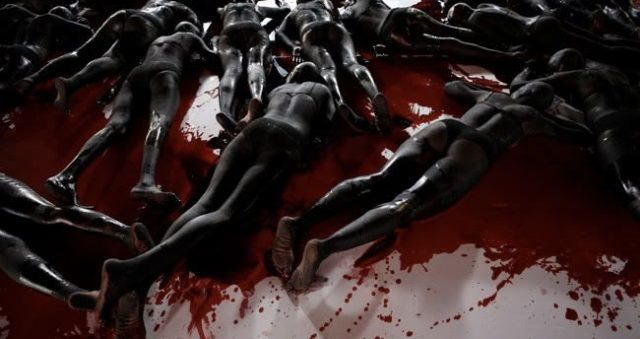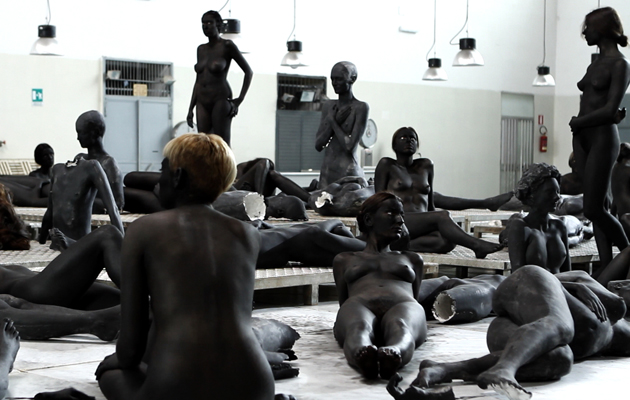
Vanessa Beecroft, “VB66,” Mercato lttico, Napoli, 2010.
We were going to write a blog post titled “Vanessa Beecroft is the Rachel Dolezal of the Art World” and then realized what an unfair comparison that is. Beecroft’s appropriations of blackness are so, so much worse. This is not a post about stupid things someone has said once, twice, or in the case of Beecroft, many, many times. This is a post about how systemic racism cannot be wished away: “If I don’t call myself white, maybe I am not,” says Beecroft in “The Bodies Artist,” a profile published online today on the Cut (as well as this month’s issue of New York Magazine). Published two years to date on the anniversary of Michael Brown’s shooting death in Ferguson, there are many people who cannot find themselves in a place to change their race—or gender, or sexual preference. Beecroft can perform blackness, but that’s her privilege. Her totally, insanely un-self-aware privilege.
On that note, here’s a round-up of press, including the just published article, that explains why Beecroft is the worst.
Let’s Go Back to 2008.

Vanessa Beecroft, “Madonna With Twins,” 2006. Photographed by Matthu Placek.
Logan Hill wrote an appropriately scathing review of the 2008 documentary The Art Star and the Sudanese Twins, “in which [Vanessa Beecroft] attempts to adopt two Sudanese orphans and use them as subjects in her work. Wise to theory, Beecroft says her adoption will be ‘not just fetishization of the blacks. It will be a beginning of a relationship with that country.’ The film documents the significant gap between Beecroft’s theory and her actions.”
That gap includes the following anecdote about her need for adoption: “My husband says, ‘You are so superficial,’’ Beecroft admits. But Greg Durkin, a social anthropologist, says much worse in the film — in part because Beecroft spends months attempting to adopt these two children without informing him. (When she finds that she needs to have his approval, she considers a divorce.) He notes that Angelina Jolie’s and Madonna’s adoptions rated them ‘a lot of press and publicity…Vanessa’s always been very receptive to that.’ Beecroft blithely agrees, noting that she’s always been obsessed with ‘the romance’ of celebrity magazines.”

Scene from Vanessa Beecroft’s “VB61 Still Death! Darfur Still Deaf?” at the 2007 Venice Biennale.
From the same article, there’s that time she physically restrained nuns who tried to stop her from stripping orphans naked to use as props for a photoshoot:
Upon her arrival in the Sudan, Beecroft hurries to set up a photo shoot, hiding the cameras from the orphanage’s sisters, calling the babies ‘these poor creatures.’ Which baby should she photograph? ‘Either one or the other,’ she says, ‘it doesn’t matter.’
Repeatedly, Beecroft claims that she ‘loves this culture’ — but, in the film’s most disturbing scene, sisters from the orphanage try to stop her from stripping the children nude inside their abbey for an elaborate photo shoot. Beecroft refuses, complains, starts shooting again, and eventually loses a physical confrontation with one of the sisters, who takes the children away from her, furious that Beecroft is stripping children naked inside a church. ‘Christ, these people,’ Beecroft moans, as she barricades herself inside, pushing a pew up against the door to keep the sisters out of their own abbey.
Now, to the Present.

Vanessa Beecroft with Kanye West. Date unknown. Source: Complex.
From the Cut article, Beecroft explains the most recent incarnation of her interest in others as a sort of performance practice. “I have divided my personality,” she says. “There is Vanessa Beecroft as a European white female, and then there is Vanessa Beecroft as Kanye, an African-American male.” If only it were that easy!
However, Beecroft does recognize that her genetic makeup characterizes her differently. In the Cut, she explains that she took a DNA test to find out whether or not she comes from a line of African ancestors. Well, she doesn’t, but she suggests that maybe she’ll take another test because she thinks science might be wrong: “I even did a DNA test thinking maybe I am black? I actually wasn’t. I was kind of disappointed, and I don’t want to believe it. I want to do it again, because when I work with Africans or African-Americans, I feel that I am autobiographical. If I don’t call myself white, maybe I am not.”

Vanessa Beecroft, “VB64,” 2009.
Other lowlights from the article:
- The roots of her fascination: “When I was a child, I won a prize at school for drawing black children in a ship….There were probably 30 or 40 of them. A lot. I drew so many of them, and I won a prize because the sisters of the nursery school were kind of mesmerized. So you see, everything comes from somewhere.” Oh wow! Beecroft’s exploitation of black bodies started by putting them in a boat—where have we heard that before?
- A curious misdefinition of favela: “These days, Beecroft and [husband] Spadoni live in a house they call their ‘favela.’ It is at the top of a series of winding roads just below the HOLLYWOOD sign.” Real favelas are slums, often riddled with crime, and lack basic sanitation services. She and her husband are now full-time employees of Kanye West, according to the Cut; one can only hope that her salary lets her afford plumbing.
Let’s Not Forget Other Recent Quotes…

Vanessa Beecroft, “VB66,” 2010.
- That time she styled Kanye’s Yeezy for Adidas fashion show (a collection so decadent that its shoes can cost more than $5,000, and which is produced by one of the worst sweatshop offenders in the industry) as poverty-themed: “featuring some 1,500 people dressed in dyed clothing (from Adidas and thrift stores) in a re-creation of a photograph taken of refugees escaping the genocide in Rwanda. ‘That was a random pick,’ she says. ‘The image came out of one of my books, and I thought, perhaps this is Woodstock, because it looked really fashionable and glamorous, but no. That was a refugee camp…I wanted the people to look poor. Poverty and elegance were the key words. Poverty and elegance. No trends, no fashion. Real poverty, what you encounter when you travel to Africa, Mexico, those countries where people wear their clothes with dignity and they look elegant and they look like they have intelligence. When we were casting, I said, ‘Please don’t have anyone who looks stupid. Or fancy. Please. Classical, poor, and elegant.’”
- That time she and Maya Rudolph (who is African American) were supposed to have a dialog, but it turned into Beecroft dominating the conversation with anecdotes about her literally nursing Sudanese orphans back from the brink of death, name-dropping, sedating her children, and of course the ridiculous quote: “I thought, Why am I leaving this country that feels so progressive, so socially and racially mixed? … I’d been raised on the idea that America meant imperialism and capitalism. Americans were killing their own presidents. They were killing Martin Luther King. They were drinking Coca-Cola. But then I got here and I saw that it wasn’t true, that it was in fact a modern country with the Helvetica font everywhere….But here you could do anything you wanted. You could eat a watermelon in the subway.” Yes, Vanessa, Helvetica font in LA is a sure sign that everything is going just fine in America, despite that whole MLK issue. Note that this “conversation” took place in May, 2016, about a year after Freddie Gray’s murder and days after George Zimmerman launched an online auction of the gun he used to kill Trayvon Martin, concurrently with the sole African American women at West Point Academy facing penalties for posing in a photo that stirred up right-wing fears of a Black Power conspiracy. How is a 1961 Hollywood musical more politically aware than a contemporary artist?
- At least Vanessa Beecroft has admitted that she feels bad about some of the art she’s making. “My work embarasses me,” she said during an interview with that German magazine Stern. That was in 2006. A decade later…


Comments on this entry are closed.
{ 2 trackbacks }